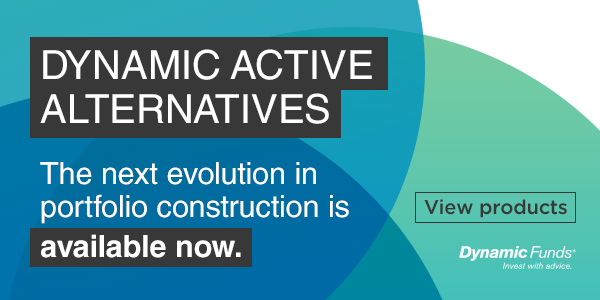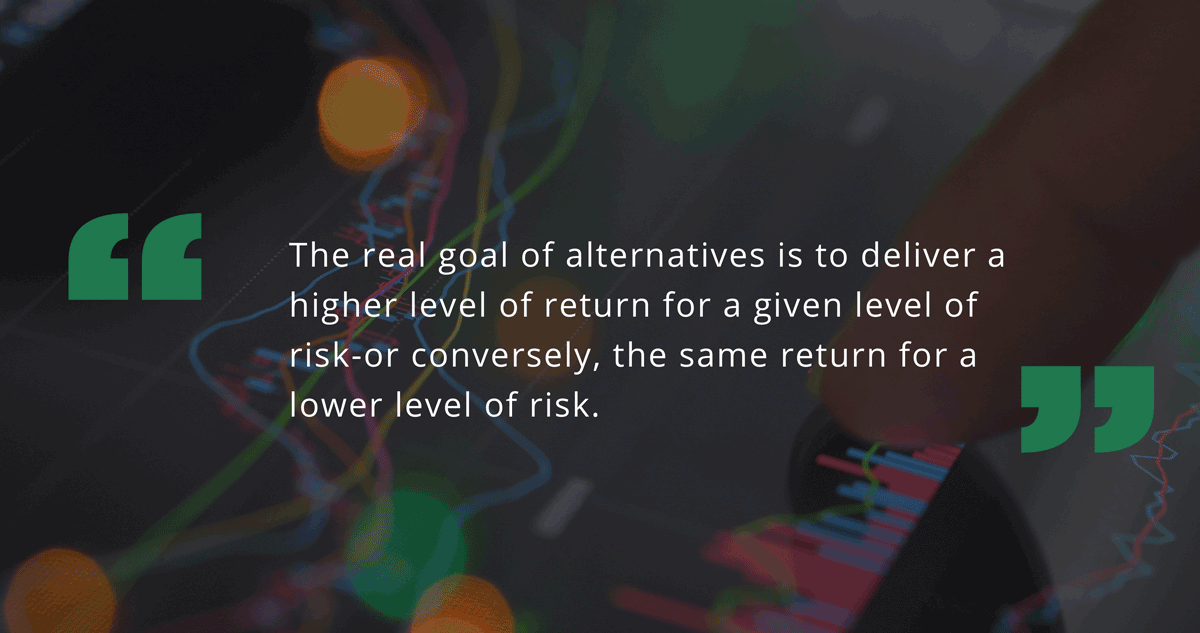Alternative Investments:
An Atypically Conventional
Portfolio Tool
by Myles Zyblock,
Chief Investment Strategist, Dynamic Funds
October 18, 2018
by Myles Zyblock, Chief Investment Strategist, Dynamic Funds
The Canadian Securities Administrators' proposed amendments to National Instrument 81-102 are expected to be adopted later this year and could pave the way for a slew of alternative funds to be available before the end of 2018. Here are some key thoughts to help advisors implement a successful alternatives strategy for their clients.
Getting Started: Alternative Assets Defined
There are many different definitions and interpretations of what alternative assets are. It's a very broad universe, but when I think about alternatives there's really two defining characteristics that I always look for: 1) a low correlation with traditional asset classes (i.e., stocks and bonds) and 2) a positive expected return, because low correlation, in and of itself, doesn't necessarily benefit an investor.
Alternative assets would include both liquid assets, like commodities and currencies, and illiquid assets, like private equity and direct real estate ownership.
Then when you think about alternatives, you can think of two distinct categories: alternative assets and alternative strategies. Alternative assets would include both liquid assets, like commodities and currencies, and illiquid assets, like private equity and direct real estate ownership. Meanwhile, alternative strategies comprise a broad range of investment strategies, including long-short, market neutral and volatility strategies, just to name a few.
Alternative strategies comprise a broad range of investment strategies, including long-short, market neutral and volatility strategies, just to name a few.
While there's a lot to consider when it comes to assessing strategies, each one should ultimately be evaluated on its ability to provide a low correlation to traditional assets and a positive expected return. Investors and advisors alike will be well served if they always keep these two criteria in mind.
It's All About Diversification
It's worth stressing that the main purpose of adding alternative assets to your portfolio is to increase diversification and improve risk-adjusted returns. You shouldn't buy an alternative fund because you're bearish on traditional assets; they shouldn't be thought of as portfolio hedges. If you're bearish on U.S. equities, buy a put option on the S&P 500, for example. The real goal of alternatives is to deliver a higher level of return for a given level of risk-or conversely, the same return for a lower level of risk.
It's also worth noting that an allocation to alternatives may not boost performance in all investment windows; but, the longer the horizon the more likely the strategy will augment performance. Because they're largely uncorrelated to stocks and bonds, alternatives might lag equities in certain markets and outperform in others. Keep in mind that it's the risk-return trade-off you're trying to manage in order to get a more reliable, more robust return stream. Remember, it's all about diversification.
Choosing an alternative fund: Track record matters
One of the things that we struggle with in Canada is finding long-term track records of managing alternative strategies through multiple market cycles. If you can find managers with track records of four or five-plus years managing alternative strategies, then I think you're already ahead of the game.
Seeing a fund's track record doesn't guarantee anything about the future, but it will tell you how these alternative assets have performed over different market environments and how the portfolio manager has guided the fund.
Considering Allocation: How much is enough?
To get the benefits of any asset class, you have to have a significant allocation to see an impact. Just as a 2% equity position won't dramatically impact one's portfolio, investors shouldn't expect magic from a similar allocation to alternatives. It's not enough exposure to change the game. You have to have a realistic expectation of what you want out of these alternative return streams and then align your allocation accordingly.
Surveying the investment landscape, we generally find that institutional investors and endowments have about a quarter of their portfolios in alternative assets. These are very long-term investors who understand the diversification benefits of adding alternatives.
So, what's the right number for retail investors? Theoretically, it might be 25-30%. However, if your client can't handle a 30% exposure when the strategy isn't working-and all strategies at times don't work-then that's too much. Ultimately, it depends on the investor's risk tolerance and their long-term investment goals. That being said, an allocation in the range of 5-25% is probably a good place to start.
When's the best time to add alternatives?
There's been a lot of speculation about where we are in the market cycle. We might be at the end of a long bull run; then again the bull market may continue for a few more years. There was a lot of talk about "irrational exuberance" in regard to the U.S. equity market in 1996, but it continued to appreciate for another five years.
The one thing I would advise against is trying to time the ins and outs of an alternative strategy. You want to have a target allocation and be fairly static on that allocation and maintain a long-term approach. Alternative assets are there to diversify your portfolio; they're not there to trade. If you take a long-term view of investing, anytime is the right time for alternatives. After all, the ultimate goal is to help investors to sleep better at night with a more reliable, consistent return stream.
To learn more about alternatives, visit Dynamic Active Alternatives
About Myles Zyblock
Myles Zyblock is a recognized strategist in North America, regarded for his investment insights that blend the tools of finance and psychology in order to capture major inflection points in financial markets. He has over 20 years of experience in guiding and advising on asset allocation for a diverse set of institutional and retail advisors across North America, Europe and Asia. Myles joined Dynamic Funds in 2013 as Chief Investment Strategist, working closely with the Dynamic Funds portfolio management team. His experience spans across multiple asset classes and geographic regions. Myles is also the Portfolio Manager of Dynamic U.S. Sector Focus Class and Dynamic Global All-Terrain Fund, which are Dynamic's first rules-based offerings.
Disclaimer:
Commissions, trailing commissions, management fees and expenses all may be associated with mutual fund investments. Please read the prospectus before investing. Mutual funds are not guaranteed, their values change frequently and past performance may not be repeated. Views expressed regarding a particular company, security, industry or market sector should not be considered an indication of trading intent of any funds managed by 1832 Asset Management L.P. These views are not to be considered as investment advice nor should they be considered a recommendation to buy or sell. Dynamic Funds® is a registered trademark of its owner, used under license, and a division of 1832 Asset Management L.P.

